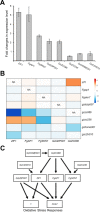Genome-wide functional characterization of putative peroxidases in the head blight fungus Fusarium graminearum
- PMID: 28387997
- PMCID: PMC6638050
- DOI: 10.1111/mpp.12557
Genome-wide functional characterization of putative peroxidases in the head blight fungus Fusarium graminearum
Abstract
Reactive oxygen species (ROS) are associated with various developmental processes and host-pathogen interactions in pathogenic fungi. Peroxidases are a group of ROS-detoxifying enzymes that are involved in the oxidative stress response and in a variety of physiological processes. In this study, we performed a genome-wide functional characterization of putative peroxidase genes in Fusarium graminearum, a head blight pathogen of cereal crops. We identified 31 putative peroxidase genes and generated deletion mutants for these genes. Twenty-six of the deletion mutants showed developmental phenotypes indistinguishable from that of the wild-type, and five deletion mutants exhibited phenotypic changes in at least one phenotypic category. Four deletion mutants, fca6, fca7, fpx1 and fpx15, showed increased sensitivity to extracellular H2 O2 . Deletion mutants of FCA7 also exhibited reduced virulence and increased trichothecene production compared with those of the wild-type strain, suggesting that Fca7 may play an important role in the host-pathogen interaction in F. graminearum. To identify the transcription factors (TFs) regulating FCA6, FCA7, FPX1 and FPX15 in response to oxidative stress, we screened an F. graminearum TF mutant library for growth in the presence of H2 O2 and found that multiple TFs co-regulated the expression of FCA7 under oxidative stress conditions. These results demonstrate that a complex network of transcriptional regulators of antioxidant genes is involved in oxidative stress responses in this fungus. Moreover, our study provides insights into the roles of peroxidases in developmental processes and host-pathogen interactions in plant-pathogenic fungi.
Keywords: Fusarium graminearum; oxidative stress response; peroxidase.
© 2017 BSPP AND JOHN WILEY & SONS LTD.
Figures






Similar articles
-
Genetic and Transcriptional Regulatory Mechanisms of Lipase Activity in the Plant Pathogenic Fungus Fusarium graminearum.Microbiol Spectr. 2023 Jun 15;11(3):e0528522. doi: 10.1128/spectrum.05285-22. Epub 2023 Apr 24. Microbiol Spectr. 2023. PMID: 37093014 Free PMC article.
-
Characterization of two catalase-peroxidase-encoding genes in Fusarium verticillioides reveals differential responses to in vitro versus in planta oxidative challenges.Mol Plant Pathol. 2018 May;19(5):1127-1139. doi: 10.1111/mpp.12591. Epub 2017 Oct 24. Mol Plant Pathol. 2018. PMID: 28802018 Free PMC article.
-
The stress-activated protein kinase FgOS-2 is a key regulator in the life cycle of the cereal pathogen Fusarium graminearum.Mol Plant Microbe Interact. 2012 Sep;25(9):1142-56. doi: 10.1094/MPMI-02-12-0047-R. Mol Plant Microbe Interact. 2012. PMID: 22591226
-
Transcriptomics of cereal-Fusarium graminearum interactions: what we have learned so far.Mol Plant Pathol. 2018 Mar;19(3):764-778. doi: 10.1111/mpp.12561. Epub 2017 Jun 7. Mol Plant Pathol. 2018. PMID: 28411402 Free PMC article. Review.
-
Exploration of the interactions between mycoviruses and Fusarium graminearum.Adv Virus Res. 2020;106:123-144. doi: 10.1016/bs.aivir.2020.01.004. Epub 2020 Feb 5. Adv Virus Res. 2020. PMID: 32327146 Review.
Cited by
-
A Phenome-Wide Association Study of the Effects of Fusarium graminearum Transcription Factors on Fusarium Graminearum Virus 1 Infection.Front Microbiol. 2021 Feb 11;12:622261. doi: 10.3389/fmicb.2021.622261. eCollection 2021. Front Microbiol. 2021. PMID: 33643250 Free PMC article.
-
Sulfur metabolism-mediated fungal glutathione biosynthesis is essential for oxidative stress resistance and pathogenicity in the plant pathogenic fungus Fusarium graminearum.mBio. 2024 Jan 16;15(1):e0240123. doi: 10.1128/mbio.02401-23. Epub 2023 Dec 19. mBio. 2024. PMID: 38112432 Free PMC article.
-
Comparative acetylome analysis reveals the potential roles of lysine acetylation for DON biosynthesis in Fusarium graminearum.BMC Genomics. 2019 Nov 12;20(1):841. doi: 10.1186/s12864-019-6227-7. BMC Genomics. 2019. PMID: 31718553 Free PMC article.
-
Broad-spectrum chemicals block ROS detoxification to prevent plant fungal invasion.Curr Biol. 2022 Sep 26;32(18):3886-3897.e6. doi: 10.1016/j.cub.2022.07.022. Epub 2022 Aug 5. Curr Biol. 2022. PMID: 35932761 Free PMC article.
-
Integrative glycomic analysis reveals the crucial role of protein glycosylation in fungal pathogenesis.PLoS Pathog. 2025 Jul 7;21(7):e1013325. doi: 10.1371/journal.ppat.1013325. eCollection 2025 Jul. PLoS Pathog. 2025. PMID: 40623063 Free PMC article.
References
-
- Apel, K. and Hirt, H. (2004) Reactive oxygen species: metabolism, oxidative stress, and signal transduction. Annu. Rev. Plant Biol. 55, 373–399. - PubMed
-
- Arunachalam, C. and Doohan, F.M. (2013) Trichothecene toxicity in eukaryotes: cellular and molecular mechanisms in plants and animals. Toxicol. Lett. 217, 149–158. - PubMed
-
- Bowden, R.L. and Leslie, J.F. (1999) Sexual recombination in Gibberella zeae . Phytopathology, 89, 182–188. - PubMed
-
- Camhi, S.L. , Lee, P. and Choi, A.M. (1995) The oxidative stress response. New Horiz. 3, 170–182. - PubMed
Publication types
MeSH terms
Substances
LinkOut - more resources
Full Text Sources
Other Literature Sources
Miscellaneous

